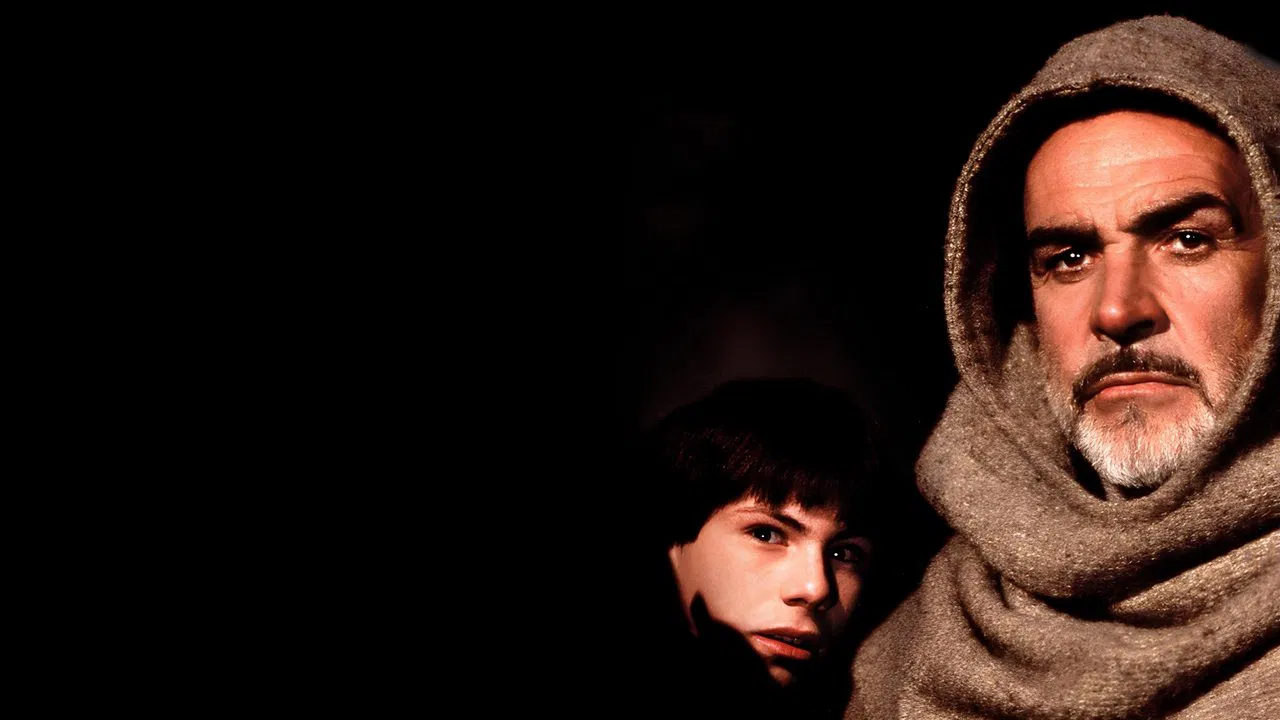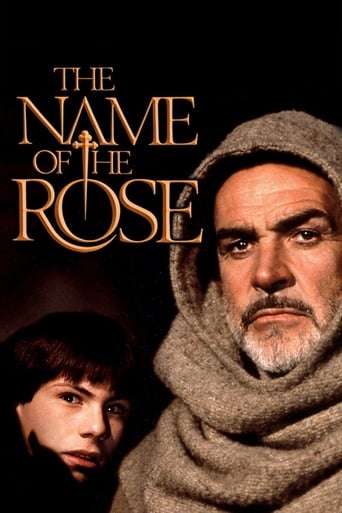

Excellent. The story, plot, and (in my opinion) production is awesome. The direction great. I always felt I was watching people from those times, more or less... The less is because of Connery and Slater, which I think they both sucked not at acting, but talking. They just didn't nail the tones and ways of speaking. The clear Sherlock Holmes tones and references weren't good.
... View MoreWhen I was 15, I found a book, Name of the Rose. This book was different because teached me about history and the main people's value: the trust. Many friend asked me what is the reason why this book was great to me and I answered them that it was very dificult to read and to understand and I had to concentrate many time. I recomend you read it. It's a cool oportunity to learn. I suggest that you read it, I am sure that you will find things that you never have founded.
... View MoreAdapting a book of more than 600 pages to the big screen wasn't a easy job, even with the collaboration of 4 screenwriters under the supervision of the 'artsy' french director, Jean-Jacques Annaud, fresh from the critical success of his previous work, "Quest for Fire" ('81) and even the author, the Italian novelist Umberto Eco, knew that, but he gave the approval and after 4 years of preparations, the production starts filming a palimpsest of his 1980 historical murder mystery debut novel. "The Name of the Rose" is a well-crafted drama / mystery / 'whodunit' film, set in the Medieval Era and telling the story of a Franciscan Friar, William of Baskerville (Sean Connery), a wise middle-age man with great power of deduction and his young novice, Adso of Melk (Christian Slater) which arrive to a somber Benedictine Abbey in northern Italy, during the wintertime, to participate in a debate with Papal emissaries about the excess of wealth in the Church. The Abbey is covered in sorrow and fear because of the recent demise of a young attractive manuscript illuminator, in a deemed unnatural way, which prompted the Brothers to suspect that was the work of the Devil. The Abbot (Michael Lonsdale) asks William for help to solve the mystery and to calm the Abbey's population before his last resort of demanding the Holy Inquisition, led by the ruthless Bernardo Gui (F. Murray Abraham), to find the guilty using their own sadistic methods...Eco's choice of naming his protagonist William of Baskerville was a clearly homage to Sir Arthur Conan Doyle's mystery novel, "The Hound of Baskervilles" featuring his most famous creation, Sherlock Holmes and his inseparable & dearest partner and future chronicler, Doctor John Watson, here personified by the young Adso which also serves as the narrator, telling us the terrifying events which occurred in the ancient Abbey, many years later. The name William is also believed to be based on the English Franciscan Friar, William of Ockham, a Scholastic Philosopher, well known for his significant works on logic, physics and theology. He even created a methodological principle called "Occam's razor".Now, what more can be said about this sterling piece of art ? The direction is top notch as so are the high production values involved: the locations; the Art Direction, Set Decoration and Costume Design; the Makeup Department (where were the Oscar nominations ?), all together makes this movie experience looks and feels like we're in the Middle Age, it's probably one of the best films ever made depicting the life in the Dark Ages, the authenticity is astonishing !! The cinematography by Tonino Delli Colli is splendid, giving a visually eerie feeling and a realistic gloomy look at the secular Abbey, especially the sequences inside the labyrinthic library (amazingly designed in the Gothic architectural style by the Production Designer Dante Ferretti) that were masterfully shot. Last, but not the least, James Horner's haunting compositions embraces the viewer into the intricate mystery helping to establish the moody tone of the movie.The cast is superb, kudos to the casting director and Annaud himself for selecting some of the most unforgettable and distinctive faces ever put on-screen. Sean Connery was tailor made for this kind of role, playing the open-minded William of Baskerville who can see the light of reason in a time of blind faith. After almost a decade into oblivion appearing in lesser known films as the romantic lead, the then 55 years old (but looked a bit older) ex-James Bond, convinced Annaud that he can do justice to William of Baskerville and he did and with that career decision, Connery re-invented his screen persona in the mid to late 80's, becoming, with major success, the Mentor of the protagonist for the rest of his career ("Highlander", "The Presidio", "Indiana Jones and the Last Crusade", "Family Business" and so on...). Christian Slater at 16 years old, have here is breakthrough role as Adso of Melk, participating in a way graphic sex scene with the 22 years old actress Valentina Vargas, who shocked the censors in America and UK, but as a French / Italian / German co-production, this seemed more common, natural and harmless there. F. Murray Abraham, in his first film after he won the Academy Award for performing Salieri in "Amadeus" ('84), is always 'machiavellian' and 'over-the-top' playing the antagonist, and Bernardo Gui, the head of the Holy Inquisition, fits him like a glove. Michael Lonsdale, Volker Prechtel, William Hickey, Elya Baskin and Helmut Qualtinger are all outstanding in their supporting roles, but the then 81 years old Feodor Chaliapin, Jr. as the blind Venerable Jorge de Burgos and the great character actor and forever typecast in this kind of monstrous roles, Ron Perlman as the hunchback Salvatore, both stole the movie every time they're on-screen. Perlman was, criminally, snubbed from an Academy Award nomination, probably he gave the best supporting performance of 1986.The only complaint about this production is that the third act feels rushed to finish the movie and was edited in a way that breaks the unsettling pace established earlier, maybe with more half a hour the movie could have been even better and escalate to the top of the best 'whodunit' ever made.In short, what Ron Howard did, exactly 20 years later, adapting the similar themed puzzling mystery, "The Da Vinci Code" with a routine & by-the-numbers direction and collecting all the accolades, Annaud did it first and better, giving us a truly memorable film, a triumph in craftsmanship, misunderstood when it was released (Roger Ebert gave it a lacklustre review), but re-appreciated and re-evaluated in more recent times and occupying nowadays the podium of one of the best films that came out of the 80's decade. For fans of a great & thrilling detective story, out of the Hollywood's standards, who also makes the viewer think, this is a must-see film.Highly recommended !!
... View MoreExcellent performance from Sean Connery as the highly intelligent detective Monk and an equally good early performance from a young Christian Slater as the eager, willing and humanly flawed pupil to Sean Connery's wise teacher. Slater is also confused about his calling and his feelings towards a local peasant girl, also look out for Ron Pearlman of Hellboy fame in a role as a heretic hunchback. The plot and story line is gripping. It had me guessing until the very end. What makes this a great film is the cinematography, locations and acting. Connery is superb as the sometimes child like detective Monk. Slater is fantastic as Connery's novice. The directing of the film, the sets and of course the scripts all perfectly intermingle to make you feel a part of a 14th century Italian monastery.The film is beautifully set in an Italian monastery that looks like it is straight out of the 14th century, the film is an excellent twist on a murder mystery It's the work of the Devil. That's what some say when a bizarre series of deaths strikes a 14th-century monastery. Others find links between the deaths and the book of Revelation. But Brother William of Baskerville thinks otherwise. He intends to find a murderer by using fact and reason, the tools of heresy. The film is very realistic in every way the cold,uncomfortable monastery; the graphic murders; grotesque and disfigured characters; a startlingly explicit sex scene; authentic-sounding dialogue; excellent indoor and outdoor locations; and well-researched costume designs. Furthermore, it is a superbly paced film.Overall rating: 9 out of 10.
... View More